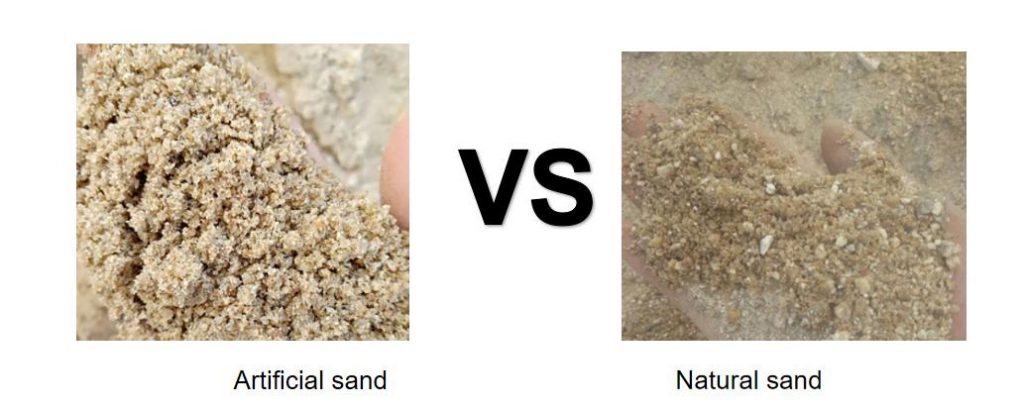When it comes to ordinary cement concrete, both machine-made sand and natural sand have their own characteristics. Let’s explore their advantages and disadvantages from multiple dimensions for a comprehensive contrast.

1. Resource Availability
Natural Sand: Natural sand is sourced from rivers, lakes, and seashores. However, over – exploitation of natural sand has led to serious ecological problems, such as riverbed degradation, damage to aquatic habitats, and disruption of the natural river ecosystem. As a result, many regions have imposed strict regulations on natural sand mining, leading to a shortage of supply in some areas. The limited availability of natural sand has also caused price fluctuations, making it less stable in the long – term for large – scale construction projects.
Machine-made Sand: Machine-made sand is produced by crushing rocks, stones, or industrial waste materials. It can be sourced from a wide range of raw materials, including granite, limestone, and basalt. Since it is manufactured artificially, the production can be adjusted according to market demand, ensuring a relatively stable supply. This makes machine-made sand a more sustainable option in the context of depleting natural resources.
2. Particle Characteristics
Natural Sand: Natural sand usually has a more rounded particle shape due to the long – term action of water flow and friction. This smooth particle shape reduces the internal friction between particles, which is beneficial for the workability of concrete. It allows the concrete mixture to flow more easily during pouring, facilitating the construction process, especially for complex structures. However, natural sand may have an irregular particle size distribution, with some particles being too fine or too coarse, which may affect the strength and durability of the concrete if not properly graded.
Machine-made Sand: Machine-made sand has an angular particle shape, which increases the interlocking effect between particles. This can enhance the mechanical properties of concrete, such as compressive strength and flexural strength. Moreover, machine-made sand can be precisely graded during the production process, ensuring a more uniform particle size distribution. However, the angular shape also increases the surface area of the sand particles, which may require more cement paste to coat the particles, resulting in higher cement consumption and potentially higher costs.
3. Chemical Composition
Natural Sand: The chemical composition of natural sand can vary depending on its source. It may contain impurities such as clay, silt, and organic matter. These impurities can reduce the bond strength between the sand and the cement paste, leading to a decrease in the overall strength of the concrete. Additionally, some impurities may react with the cement over time, causing volume changes and potential durability issues.
Machine-made Sand: Machine-made sand has a more consistent chemical composition as it is produced from selected raw materials. It can be processed to remove most of the impurities, resulting in a cleaner product. This purity helps to ensure a more stable chemical reaction between the sand and the cement, improving the durability and long – term performance of the concrete.
4. Cost
Natural Sand: Due to its limited availability and high demand, the cost of natural sand has been rising in recent years. In addition, the transportation cost of natural sand can be significant, especially when the source is far from the construction site. These factors combined make natural sand a relatively expensive option for concrete production.
Machine-made Sand: Although the initial investment in machine-made sand production equipment is high, the cost of raw materials for machine-made sand is usually lower. Moreover, as the production technology improves, the production cost of machine-made sand is gradually decreasing. In some regions, machine-made sand has become more cost – effective than natural sand, especially when considering the overall cost of concrete production, including transportation and potential quality control costs.
In conclusion, while natural sand has some advantages in terms of workability, its resource limitations and potential quality issues due to impurities are significant drawbacks. Machine-made sand, on the other hand, offers more stable supply, better control over particle characteristics and chemical composition, and in some cases, cost – effectiveness. However, it also has challenges such as higher cement consumption. The choice between machine-made sand and natural sand in ordinary cement concrete depends on various factors, including local resource availability, project requirements, and cost considerations.
